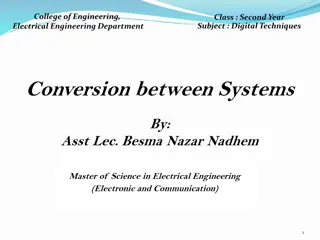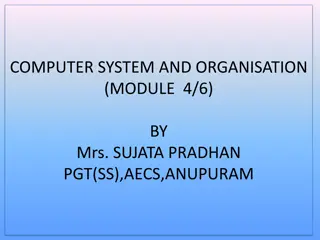Understanding IP Addressing and Conversion from Binary to Decimal
Learn about IP addressing, including binary notation, dotted-decimal notation, and the process of converting binary numbers to decimal. Explore the unique features of IP addresses and the steps involved in converting binary to decimal systematically.
Download Presentation

Please find below an Image/Link to download the presentation.
The content on the website is provided AS IS for your information and personal use only. It may not be sold, licensed, or shared on other websites without obtaining consent from the author. Download presentation by click this link. If you encounter any issues during the download, it is possible that the publisher has removed the file from their server.
E N D
Presentation Transcript
IP Addressing and Network Software
IP Addressing For this level of communication, we need a global addressing scheme; we called this logical address or IP address. The IP address is 32 bits in length. IP addresses are unique. They are unique in the sense that each address defines one, and only one, connection to the Internet. Two devices on the Internet can never have the same address at the same time.
Binary Notation In binary notation, the IP address is displayed as 32 bits. Each octet is often referred to as a byte. Example: 01110101 10010101 00011101 00000010
Dotted-Decimal Notation To make the IP address more compact and easier to read. The IP address is written in decimal form with a decimal point (dot) separating the bytes. Example: 117.149.29.2 Note that because each byte (octet) is 8 bits, each number in dotted-decimal notation is a value ranging from 0 to 255.
How to Convert from Binary to Decimal Step1 Write down the binary number and list the powers of 2 from right to left.
How to Convert from Binary to Decimal Step 2 Write the digits of the binary number below their corresponding powers of two.
How to Convert from Binary to Decimal Step 3 Connect the digits in the binary number with their corresponding powers of two.
How to Convert from Binary to Decimal Step 4 Write down the final value of each power of two.
How to Convert from Binary to Decimal Step 5 Add the final values.
How to Convert from Binary to Decimal Step 6 Write the answer along with its base subscript.
Classes There are five classes of IP addresses, Class A through Class E. We can find the class of an address when given the address in binary notation or dotted-decimal notation. If the address is given in binary notation, the first few bits can immediately tell us the class of the address. If the address is given in decimal-dotted notation, the first byte defines the class.
Classes Each class is divided into a fixed number of blocks (that indicate the number of the networks) with each block having a fixed size (the number of the host). An IP address in class A, B, or C is divided into netid and hostid. These parts are of varying lengths, depending on the class of the address
Classes Addresses in classes A, B, and C are for the unicast communication, from one source to one destination. Addresses in class D are for multicast communication, from one source to a group of destinations. Multicast address can be used only as destination address, but never as a source address.
Class A The first octet indicates the number of the network, and the remaining three octets indicate the number of the host. 126 network addresses 16 million hosts per network
Class A Network range from 1- 126
Class B The first two octets indicate the network number, and last two octets indicate the host. It is intended for organizations that have more networks, but not as many hosts per network. 16,384 network addresses 65,534 hosts per network
Class B Network range from 128 - 191 IP 127 is reserved for loop back and for internal testing on a local machine. [You can test this: you should always be able to ping 127.0.0.1, which points to yourself]
Class C The first three octets are for the network number, and last octet is for the host. It is intended for organizations that have many networks, but few hosts per network. Over 2 million network numbers 254 hosts per network
Class C Network range from 192 - 223
Other Classes Class D and Class E addresses are for special uses. Class D: Class D network range 224-239 Class D addresses are reserved for multicasting. Class E: Class E network range 240-254 Class E addresses are reserved for future use Special IP addresses are known as private addresses.
30 Subnetting When an organization is given a block of class A, B, or C address, the first address in the block defines the network address. This address is used by routers outside the organization to route the packets destined for the network. The outside world, when it comes to routing, recognize the network, not individual hosts on the network.
31 Subnetting As known, the IP address is divided to netid and hostid. To reach a host on the internet, we must first reach the network by using the netid. Then we must reach the host itself by using the hostid. i.e. the IP addresses are designed with two levels of hierarchy.
33 Example
34 Subnetting Sometimes, an organization needs to assemble the hosts into groups; the network needs to be divided into several subnetworks (subnets).
35 Subnetting Subnetting a network can be done for a variety of reasons: A company uses two or more types of LAN technology (for example, Ethernet, Token Ring) on their network or different physical media (such as Ethernet, FDDI, WAN, etc.) Two network segments are restricted by distance limitations (for example, remote offices linked via point-to-point circuit). Segments need to be localized for network management reasons (accounting segment, sales segment, etc.). Hosts which dominate most of the LAN bandwidth need to be isolated. Security. The most common reason is to control network traffic.
36 Subnetting In subnetting, a network is divided into several smaller groups with each subnetwork ( or subnet) having its own subnetwork address. When we divide a network into several subnets, we have three level of hierarchy, network, subnet and host. Subnetting is done by borrowing bits from the host part and add them the network part
37 How it works? The IP address is split into a network and host portion. The network portion always remains fixed for a particular network, while the remaining bits which make up the host portion can be altered to give the range of addresses to assign to hosts. To determine where the network portion ends and the host portion begins, a subnet mask is used.
38 Mask When a router receives a packet with a destination address, it needs to route the packet. The routing is based on the network address and subnetwork address. The router outside the organization routes the packet based on the network address. The router inside the organization routes the packet based on the subnetwork address. But!! How can router find the network and subnetwork address
39 Mask The router outside the organization has a routing table with one column based on the network addresses. The router inside the organization has a routing table based on the subnetwork addresses. A 32-bit number called mask is the key. The router outside the organization use a default mask. The router inside the organization use a subnet mask.
40 Default Mask A default mask is 32-bit binary number that gives the network address when ANDed with an address in the block. If the bit in the mask is 1 the corresponding bit in the address is retained ( no change). If the bit in the mask is 0 0 bit in the output is the result.
41 Subnet Mask The number of 1s in a subnet mask is more than the number of 1s in the corresponding default mask. In subnet mask, we change some of the leftmost 0s in the default mask to make subnet mask. The number of subnets is determine by the number of extra1s. If the number of extra 1 is n, the number of subnets is 2n. If the number of subnets is N, the number of extra 1s is log2N
43 Example Assume the IP address is 140.179.240.200, it has a Class B default mask, perfume a logical AND: 10001100.10110011.11110000.11001000 140.179.240.200 IP Address 11111111.11111111.00000000.00000000 255.255.000.000 Subnet Mask -------------------------------------------------------- 10001100.10110011.00000000.00000000 140.179.000.000 Network Address
45 Example What is the subnetwork address if the destination address is 19.30.84.5 and the mask is 255.255.192.0?
46 Solution























